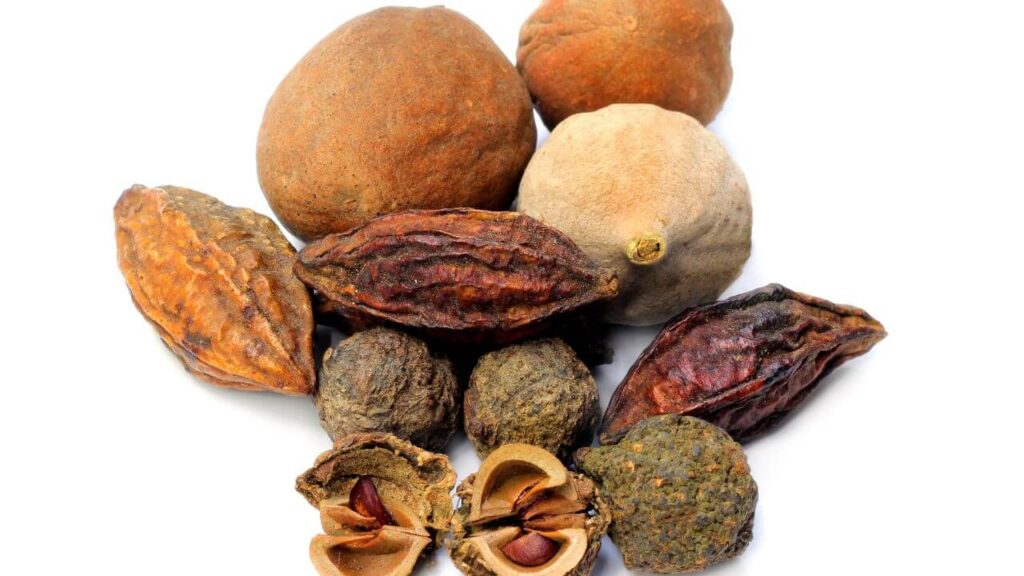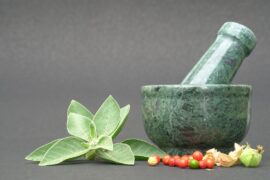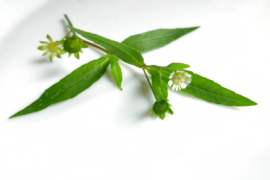Are you looking for a natural supplement that supports digestive health, boosts immunity, and promotes overall wellness? Triphala might be just what you need. This ancient Ayurvedic herbal preparation has been used for thousands of years in traditional Indian medicine and is now gaining recognition worldwide for its remarkable health benefits.
Triphala, which means “three fruits” in Sanskrit, combines three medicinal plants: amalaki (Emblica officinalis), bibhitaki (Terminalia bellirica), and haritaki (Terminalia chebula). Together, these fruits create a synergistic blend that addresses multiple aspects of health simultaneously.
In this comprehensive guide, we’ll explore the scientifically-backed benefits of Triphala and how you can incorporate this ancient formula into your modern wellness routine.
What is Triphala? Understanding the Three-Fruit Formula

Triphala isn’t just any herbal supplement—it’s considered one of the most important polyherbal preparations in Ayurveda. What makes this formula special is the balanced combination of three potent medicinal fruits, each with its own unique properties:
The Three Pillars of Triphala
Amalaki (Emblica officinalis): Also known as Indian Gooseberry or amla, this fruit is one of the richest natural sources of vitamin C and antioxidants. In Ayurvedic tradition, amalaki balances the Pitta dosha (fire element) and is revered for its cooling, rejuvenating properties.
Bibhitaki (Terminalia bellirica): This fruit specifically targets the accumulation of fluids and fats in the body. It helps balance the Kapha dosha (water and earth elements) and is known for its detoxifying effects on the respiratory, urinary, and digestive systems.
Haritaki (Terminalia chebula): Often called the “king of medicines” in Tibet, haritaki supports the body’s natural cleansing processes. It balances the Vata dosha (air and space elements) and is valued for its gentle laxative properties and ability to strengthen the digestive system.
Related: Ayurveda for Black Hair: Ancient Wisdom for Modern Coils, Kinks and Curls
Nutritional Composition and Bioactive Compounds
Triphala contains a remarkable array of beneficial compounds that contribute to its therapeutic effects:
| Component | Key Bioactive Compounds | Primary Benefits |
| Amalaki | Vitamin C, Gallic acid, Ellagic acid, Quercetin | Antioxidant, Immune support, Anti-aging |
| Bibhitaki | Gallic acid, Ellagic acid, Lignans, Saponins | Anti-inflammatory, Antimicrobial, Detoxifying |
| Haritaki | Chebulagic acid, Chebulinic acid, Tannins, Anthraquinones | Digestive support, Mild laxative, Antioxidant |
This unique combination of phytochemicals works synergistically to produce effects that are greater than what each fruit could accomplish individually. Modern scientific research has begun to validate what Ayurvedic practitioners have known for centuries—Triphala offers multiple health benefits through various biochemical mechanisms.
The 10 Science-Backed Benefits of Triphala
1. Digestive Health and Gut Function
Digestive health is perhaps the most well-known application of Triphala, and modern research strongly supports this traditional use. Triphala works through multiple mechanisms to support comprehensive digestive wellness:
Improves Gut Motility and Relieves Constipation
Research indicates that Triphala’s mild laxative properties come from its anthraquinone content, which gently stimulates intestinal contractions. Unlike harsh chemical laxatives, Triphala promotes regularity without causing dependence or depleting electrolytes.
A 2018 study published in the Journal of Alternative and Complementary Medicine found that Triphala improved bowel movement frequency and consistency in participants with chronic constipation, with effects comparable to psyllium husk but with additional benefits for overall digestive function.
Enhances Digestive Enzyme Activity
Triphala has been shown to enhance the activity of digestive enzymes such as lipase, amylase, and protease. A study published in the Journal of Ayurveda and Integrative Medicine demonstrated that Triphala supplementation increased the production and activity of these enzymes, potentially improving nutrient absorption and digestive efficiency.
Supports a Healthy Gut Microbiome
Perhaps most impressive is Triphala’s effect on gut bacteria. Research published in the Journal of Ethnopharmacology showed that Triphala acts as a prebiotic, promoting the growth of beneficial bacteria like Bifidobacteria and Lactobacillus while inhibiting the growth of potentially harmful bacteria.
As Dr. Deepak Chopra explains: “Triphala is among the most balanced of all herbal formulations. By supporting the growth of beneficial gut bacteria and enhancing digestive function, it creates the foundation for whole-body health in accordance with Ayurvedic principles.”
2. Powerful Antioxidant and Anti-Inflammatory Properties
Chronic inflammation and oxidative stress underlie many modern health concerns. Triphala offers potent protection through its rich array of antioxidant compounds:
Superior Antioxidant Capacity
The antioxidant potential of Triphala is remarkable. A study published in Molecular and Cellular Biochemistry found that Triphala extract had a higher antioxidant activity than even vitamin C in certain laboratory tests. Its ORAC (Oxygen Radical Absorbance Capacity) value—a measure of antioxidant strength—has been shown to be significantly higher than many common antioxidant foods.
Reduction of Inflammatory Markers
Research published in the Journal of Ethnopharmacology demonstrated that Triphala significantly reduced levels of inflammatory markers in laboratory studies. A 2016 study by Kalaiselvan et al. found that Triphala extract suppressed inflammatory responses in animal models of arthritis by inhibiting pro-inflammatory cytokines.
Cellular Protection
The polyphenols and tannins in Triphala provide cellular protection by scavenging free radicals and supporting the body’s natural antioxidant enzymes like superoxide dismutase (SOD) and catalase. This may help protect tissues from oxidative damage and support healthy aging.
3. Immune System Support and Disease Prevention
Triphala’s immune-enhancing properties stem from both its direct antimicrobial effects and its ability to modulate immune function:
Immunomodulatory Effects
Research published in the Journal of Ethnopharmacology showed that Triphala can enhance immune function by increasing the production of cytokines, the chemical messengers that help regulate immune responses. A clinical trial on healthy volunteers reported in Phytotherapy Research found that Triphala supplementation led to enhanced activity of natural killer cells and cytotoxic T cells, both crucial components of immune defense.
Antimicrobial Properties
Multiple studies have demonstrated Triphala’s effectiveness against various pathogens. Research published in the British Journal of Pharmaceutical Research showed that Triphala extract exhibited antimicrobial activity against common bacterial pathogens including E. coli, Staphylococcus aureus, and Pseudomonas aeruginosa.
Viral Defense Mechanisms
Emerging research also suggests potential antiviral properties. A study in the Journal of Ayurveda and Integrative Medicine found that certain compounds in Triphala may inhibit viral attachment to host cells, offering a potential protective mechanism against viral infections.
Dr. Robert Keith Wallace, a physiology researcher, notes: “The immunomodulatory effects of Triphala are particularly interesting because it appears to balance immune function rather than simply stimulating it, which is important for long-term immune health.”
4. Detoxification and Cleansing Effects
In Ayurveda, Triphala is revered for its ability to gently detoxify the system without depleting the body’s strength:
Liver Support
Research published in BMC Complementary and Alternative Medicine demonstrated that Triphala may support liver function by increasing the activity of liver enzymes that help metabolize toxins. A study on rats with induced liver damage showed that Triphala administration helped normalize liver enzyme levels and reduced markers of oxidative stress in liver tissue.
Enhanced Elimination
Triphala supports all channels of elimination in the body. Beyond its effects on bowel function, research suggests it may also support kidney function and healthy urination. A study in the Journal of Ethnopharmacology found that Triphala helped increase urine volume and electrolyte excretion in laboratory animals, suggesting a mild diuretic effect that may aid in toxin elimination.
Cellular Detoxification
At the cellular level, Triphala appears to enhance the activity of glutathione and other antioxidant systems that are crucial for neutralizing toxins and supporting cellular detoxification pathways.
5. Blood Sugar Regulation and Metabolic Health
Maintaining healthy blood sugar levels is a growing concern worldwide. Triphala shows promising effects in this area:
Improved Glycemic Control
A study published in the Journal of Medicinal Food found that Triphala extract demonstrated anti-diabetic effects in laboratory animals with artificially induced diabetes. The research showed a significant reduction in blood glucose levels and improvements in glucose tolerance.
Enhanced Insulin Sensitivity
Research suggests that the polyphenols in Triphala may improve insulin sensitivity and help cells respond more effectively to insulin. A study in the International Journal of Ayurvedic Medicine demonstrated improvements in insulin response markers in participants who took Triphala regularly for three months.
Protection of Pancreatic Cells
Some research indicates that Triphala may help protect the insulin-producing beta cells in the pancreas from oxidative damage, potentially helping maintain healthy insulin production.
6. Heart Health and Cholesterol Management
Cardiovascular health is another area where Triphala shows significant promise:
Cholesterol Balance
A clinical study published in the Journal of Ayurveda and Integrative Medicine found that participants with mildly elevated cholesterol who took Triphala powder for 12 weeks experienced a 13% reduction in total cholesterol and a 17% reduction in LDL (“bad”) cholesterol. The researchers also noted improvements in HDL (“good”) cholesterol levels.
Blood Pressure Support
Some research suggests that Triphala may help maintain healthy blood pressure levels. A study in the Journal of Basic and Clinical Physiology and Pharmacology found that Triphala administration helped normalize blood pressure in laboratory animals with induced hypertension.
Reduction of Oxidative Stress in Blood Vessels
The antioxidant properties of Triphala may help protect blood vessels from oxidative damage, potentially reducing the risk of atherosclerosis and other cardiovascular issues.
7. Weight Management Support
Triphala may be beneficial for those seeking to maintain a healthy weight:
Metabolic Enhancement
Research published in the Journal of Ethnopharmacology suggests that Triphala may help enhance metabolic rate and fat metabolism. A study in the Journal of Medicinal Food found that Triphala supplementation reduced body weight and body fat percentage in laboratory animals fed a high-fat diet.
Reduction of Fat Absorption
Some components in Triphala appear to inhibit pancreatic lipase, an enzyme that breaks down dietary fat for absorption. By moderately reducing fat absorption, Triphala may help support weight management efforts when combined with a healthy diet and lifestyle.
Blood Sugar Stabilization
By helping to stabilize blood sugar levels, Triphala may indirectly support weight management by reducing cravings and preventing energy crashes that can lead to overeating.
8. Oral Health Benefits
Triphala’s antimicrobial and anti-inflammatory properties make it particularly beneficial for oral health:
Comparable to Commercial Mouthwash
A clinical study published in the Journal of Periodontology compared a 6% Triphala mouthwash to 0.2% chlorhexidine (a standard antimicrobial mouthwash) and found that both were equally effective in reducing plaque formation and gingival inflammation after regular use. Impressively, the 2017 review by Peterson et al. noted that Triphala reduced bacterial plaque by 17-18% compared to 16% with standard mouthwash treatments.
Prevention of Dental Caries
Research in the International Journal of Ayurvedic Medicine demonstrated that Triphala extract inhibited the growth of Streptococcus mutans, a primary bacterium involved in tooth decay. Regular use of Triphala in oral care may help reduce the risk of dental caries.
Reduction of Gingival Inflammation
The anti-inflammatory properties of Triphala make it beneficial for reducing gingival inflammation and supporting overall gum health. A study in the Journal of Indian Society of Periodontology found that Triphala gel application reduced markers of gingival inflammation in patients with gingivitis.
9. Skin Health and Anti-Aging Properties
Both traditional wisdom and modern research suggest that Triphala may benefit skin health:
Antioxidant Protection
The powerful antioxidants in Triphala may help protect skin cells from oxidative damage caused by UV radiation and environmental toxins. Research in the Journal of Ethnopharmacology found that Triphala extract significantly reduced markers of photoaging in skin cells exposed to UV radiation.
Collagen Support
Some components in Triphala, particularly the vitamin C in amalaki, support healthy collagen production, which is essential for maintaining skin elasticity and preventing premature aging.
Anti-Inflammatory Effects on Skin Conditions
The anti-inflammatory properties of Triphala may be beneficial for various inflammatory skin conditions. A study in BMC Complementary and Alternative Medicine found that topical application of Triphala extract helped reduce inflammation and accelerate healing in skin wounds in laboratory animals.
10. Stress Reduction and Adaptogenic Effects
In our high-stress modern world, Triphala’s adaptogenic properties are particularly valuable:
Cortisol Regulation
Research suggests that Triphala may help regulate cortisol levels, potentially reducing the negative effects of chronic stress on the body. A study published in the Journal of Alternative and Complementary Medicine found that participants who took Triphala for 12 weeks showed reduced markers of stress and improved resilience to stressful stimuli.
Neuroprotective Effects
Emerging research points to Triphala’s potential neuroprotective effects. A 2023 study published in the Journal of Ethnopharmacology found that Triphala polyphenols showed promise in improving stress-induced depression and cognitive impairment by activating serotonin receptors and brain-derived neurotrophic factor (BDNF), which alter neuronal and synaptic plasticity.
Sleep Quality Improvement
Some research indicates that Triphala may help improve sleep quality, likely due to its stress-reducing and nervous system-balancing effects.
How to Take Triphala: Forms, Dosage, and Timing
To experience the full benefits of Triphala, it’s important to use it correctly and consistently.
Different Forms of Triphala
Triphala is available in several forms, each with its own advantages:
| Form | Description | Best For | Considerations |
| Powder (Churna) | Traditional form, fine powder of dried fruits | Maximum versatility, economic option | Strong taste, requires preparation |
| Tablets/Capsules | Compressed or encapsulated powder | Convenience, travel, avoiding taste | May contain fillers or binders |
| Liquid Extract | Concentrated liquid form | Faster absorption, easier dosing | Often contains alcohol, shorter shelf life |
| Tea | Dried herbs for brewing as tea | Gentle effects, hydration | Milder potency, preparation time |
Recommended Dosage Guidelines
While individual needs may vary, here are general guidelines based on traditional use and clinical studies:
Triphala Powder (Churna):
- Standard Dose: 1/2 to 1 teaspoon (3-5 grams) once or twice daily
- Method: Mix with warm water or take with honey to offset the bitter taste
Tablets/Capsules:
- Standard Dose: Follow manufacturer’s recommendations (typically 1000mg daily)
- Method: Take with water, preferably on an empty stomach
Liquid Extract:
- Standard Dose: 30-40 drops in water, once or twice daily
- Method: Add to water or juice
Triphala Tea:
- Standard Dose: 1 teaspoon of powder steeped in hot water for 10 minutes
- Method: Drink warm, can add honey if desired
Dr. Vasant Lad, renowned Ayurvedic physician, recommends: “Start with a smaller dose and gradually increase to the full recommended amount over a week or two. This allows the body to adjust and helps minimize any potential digestive discomfort during initial use.”
Best Time to Take Triphala
Traditional Ayurvedic wisdom offers specific guidance on timing:
Evening Use (Most Common):
- Take 30 minutes before bedtime on an empty stomach
- Supports overnight detoxification and morning elimination
- Ideal for those using Triphala primarily for digestive health and gentle cleansing
Morning Use:
- Take upon waking, 30 minutes before breakfast
- May be preferred for energy support and metabolic benefits
- Can help establish a regular morning elimination pattern
Twice Daily Use:
- For more intensive benefits, smaller doses can be taken both morning and evening
- Typically half the standard dose at each time
For most people, evening use aligns best with Triphala’s traditional role in supporting overnight detoxification and morning elimination.
How to Prepare Triphala at Home
Basic Triphala Drink (Traditional Method):
- Add 1/2 to 1 teaspoon of Triphala powder to a glass
- Add a small amount of warm water to form a paste
- Add 8 ounces of warm (not hot) water and stir well
- Let it sit for 10-12 hours (overnight), or if needed, at least 10 minutes
- Stir again before drinking
Honey-Sweetened Triphala:
- Mix 1/2 to 1 teaspoon of Triphala powder with 1 teaspoon of raw honey
- Add warm water and stir well
- Drink immediately while still warm
Triphala Tea with Spices:
- Boil 8 ounces of water with a pinch of cinnamon and ginger
- Remove from heat and add 1 teaspoon of Triphala powder
- Cover and steep for 10 minutes
- Strain if desired and add honey to taste
Potential Side Effects and Precautions
While Triphala is generally considered safe for most people, there are important considerations to keep in mind:
Who Should Avoid Triphala
Pregnancy and Breastfeeding:
- Due to limited research, pregnant and breastfeeding women should avoid Triphala or consult a healthcare provider before use
Specific Medical Conditions:
- Individuals with bleeding disorders (due to potential blood-thinning effects)
- People with severe diarrhea or dysentery
- Those with known allergies to any of the three fruits
Medication Interactions:
- May interact with blood thinners like warfarin
- Could potentially enhance the effects of diabetes medications
- May interact with certain anti-diarrheal medications
Always consult with a healthcare provider before starting Triphala if you have any underlying health conditions or are taking medications.
Possible Side Effects
Most people tolerate Triphala well, but some may experience:
Digestive Adjustments:
- Mild and temporary digestive discomfort during initial use
- Increased bowel movements or changes in consistency
- Occasional gas or bloating
Individual Sensitivities:
- Allergic reactions (rare, but possible with any herbal product)
- Taste aversion (Triphala is notably bitter)
Dosage-Related Effects:
- Taking too much may cause diarrhea or abdominal discomfort
- Long-term high doses may potentially cause electrolyte imbalances
These effects are typically mild and often subside as the body adjusts to Triphala. Starting with a lower dose and gradually increasing can help minimize these effects.
Quality Considerations When Buying Triphala
The quality of Triphala products can vary significantly. Here’s what to look for:
Organic Certification:
- Choose organic products to avoid pesticide residues
- Look for USDA Organic or equivalent certification
Testing and Purity:
- Select products tested for heavy metals and contaminants
- Reputable brands will provide information on testing practices
Whole Herb vs. Standardized Extracts:
- Traditional whole herb preparations contain the full spectrum of compounds
- Standardized extracts offer consistency in specific compounds but may lack synergistic components
Sustainable Sourcing:
- Look for companies that practice sustainable harvesting
- Fair trade certification is a plus for supporting ethical production
Reputable Manufacturers:
- Choose established brands with good manufacturing practices
- Check for third-party testing and quality certifications
Integrating Triphala into Your Wellness Routine
To maximize the benefits of Triphala, consider these strategies for making it a consistent part of your wellness practice:
Start Gradually:
- Begin with a lower dose than recommended to assess tolerance
- Gradually increase to the full dose over 1-2 weeks
- Be patient—many benefits of Triphala develop with consistent use over time
Complementary Practices:
- Support Triphala’s effects with adequate hydration
- Consider combining with other Ayurvedic practices like tongue scraping and oil pulling for oral health
- Incorporate mindful eating practices to enhance digestive benefits
Seasonal Adjustments:
- In Ayurveda, dosages may be adjusted seasonally
- Slightly higher doses may be beneficial during seasonal transitions
- Listen to your body’s needs, which may change throughout the year
Cycling Protocol:
- Some practitioners recommend taking breaks from Triphala periodically
- A common approach is to use for 3 months, then take a 2-4 week break
- This may prevent tolerance and maintain effectiveness
Remember that Triphala is meant to support—not replace—a healthy diet and lifestyle. Its benefits are most pronounced when combined with proper nutrition, regular exercise, stress management, and adequate sleep.
Conclusion
Triphala represents the perfect intersection of ancient wisdom and modern science—a time-tested formula with increasingly well-documented benefits for multiple aspects of health. From digestive support and detoxification to immune enhancement and stress reduction, this remarkable herbal blend offers a holistic approach to wellness that addresses the interconnected systems of the body.
As research continues to validate the traditional uses of Triphala, more people around the world are discovering what Ayurvedic practitioners have known for centuries: this balanced combination of three fruits offers one of the most comprehensive and gentle approaches to supporting overall health and vitality.
Whether you’re looking to improve digestive function, enhance detoxification, support healthy aging, or simply maintain overall wellness, Triphala offers a natural, evidence-based option worth considering. As with any supplement, it’s always advisable to consult with a healthcare provider before beginning use, particularly if you have underlying health conditions or are taking medications.
FAQs About Triphala
What happens if I take Triphala every day?
Daily use of Triphala is traditional in Ayurveda and generally considered safe for most people. With consistent use, you may notice improved digestion, more regular bowel movements, and over time, additional benefits like clearer skin, improved energy, and better immune function. Some people report that the full benefits of Triphala become more apparent after 2-3 months of regular use.
How long does it take for Triphala to work?
Effects vary by individual and depend on what you’re using it for. Digestive benefits like improved bowel movements may be noticed within the first week. Detoxification effects typically become apparent within 2-4 weeks. More profound systemic benefits like improved immunity or metabolic function may take 8-12 weeks of consistent use to fully manifest.
Can Triphala help with weight loss?
While not primarily a weight loss supplement, Triphala may support weight management through multiple mechanisms: improving digestion and metabolism, reducing cravings through blood sugar stabilization, supporting detoxification, and reducing inflammation. For best results, combine with a balanced diet and regular exercise.
Is Triphala safe for everyone?
Triphala is generally safe for most adults when used as directed. However, it’s not recommended for pregnant or breastfeeding women, individuals with certain medical conditions like bleeding disorders, or those taking specific medications without medical supervision. Always consult a healthcare provider before beginning any supplement regimen.
Can I take Triphala with other medications?
Triphala may interact with certain medications, including blood thinners, diabetes medications, and some digestive drugs. Always consult with your healthcare provider before combining Triphala with prescription medications. Taking Triphala at least 2 hours apart from other medications may help reduce potential interactions.
What is the difference between Triphala powder and capsules?
Triphala powder is the traditional form and may be more potent and versatile, but has a strong bitter taste. Capsules offer convenience and mask the taste but may contain additional ingredients and fillers. Some practitioners believe the taste of Triphala is part of its therapeutic action, as bitter flavors stimulate digestive processes.
Does Triphala detox the body?
Yes, Triphala supports the body’s natural detoxification processes through multiple mechanisms: enhancing elimination through the digestive system, supporting liver function, providing antioxidant protection, and promoting healthy elimination through all channels. It’s considered a gentle yet effective detoxifying agent in Ayurvedic medicine.
What does Triphala taste like?
Triphala has a complex taste that includes all six tastes recognized in Ayurveda: sweet, sour, salty, bitter, pungent, and astringent—with bitter and astringent being most prominent. Many people find the taste challenging at first, which is why honey or warm water preparations are popular, as are capsule forms.
Where can I buy high-quality Triphala?
Look for organic Triphala from reputable manufacturers who test for purity and potency. Specialty health food stores, Ayurvedic pharmacies, and trusted online retailers are good sources. Always check for quality certifications, testing practices, and reviews before purchasing.
How do I know if Triphala is working for me?
Signs that Triphala is working may include improved digestion, more regular bowel movements, increased energy, clearer skin, reduced inflammation, and generally feeling better. Keep a journal of your experience to track changes, which are often subtle and progressive rather than dramatic.







